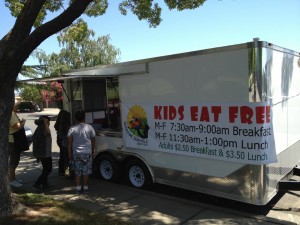
To understand some of the powerful hunger issues in our state, go no further than the Silicon Valley YMCA.
The Y runs summer youth programs in Gilroy. Vice president of programming and community development Mary Hoshiko Haughey says last summer they had a boy in the middle school group who wasn't eating his lunch.
"This was the first day of the program, and our staff asked 'Why aren’t you eating?' 'What would you like?'" Haughey recalled. "And he said, 'I can’t eat because I need to make sure my brother and sister are eating. Do they have food in their program too? Otherwise I have to save it for them.' And finally we put him on the phone with them at another site and they said 'yes, we’re eating,' so he finally did too."
Haughey paused. "It’s an example of the adult issues that our young children are taking on. He wasn’t going to eat unless he knew his siblings would.”
It's also an example of the importance of the summer meal programs that are offered throughout the state. Some school-based programs directly continue the work of the School Lunch Program and Summer Food Service Program that serves free and reduced meals to low income students throughout the year. Others are sponsored by food banks or summer youth program sites.